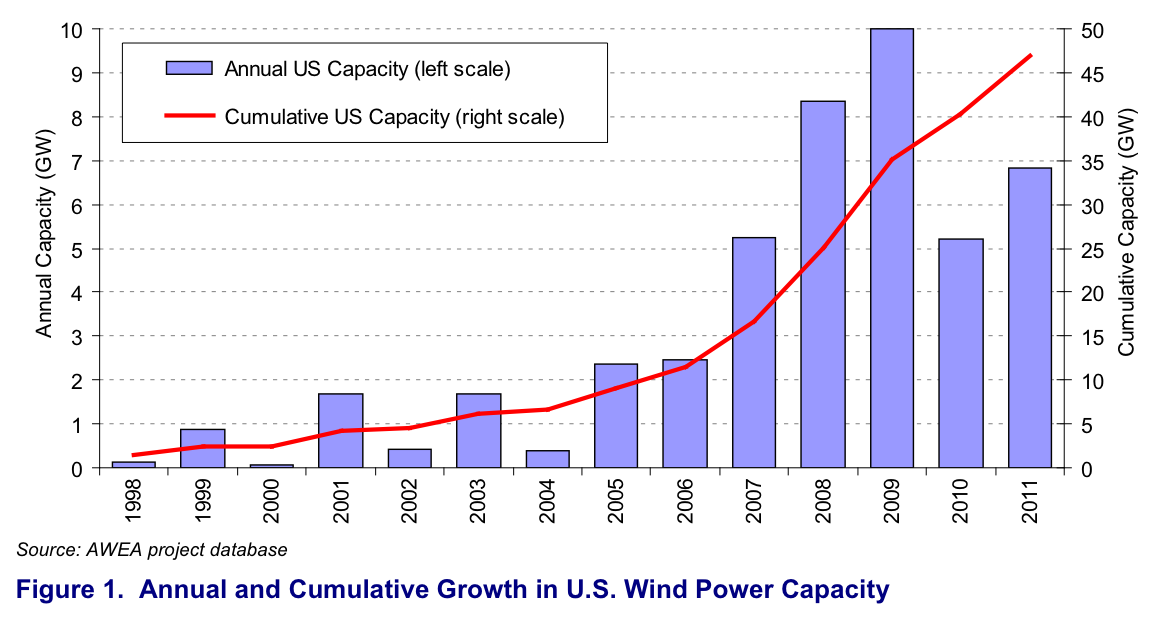U.S. DEPARTMENT OF ENERGY
Introduction
The U.S. wind power industry is facing uncertain times. With 2011 capacity additions having risen from 2010 levels and with a further sizable increase expected in 2012, there are – on the surface – grounds for optimism. At the same time, the currently-slated expiration of key federal tax incentives for wind energy at the end of 2012 – in concert with continued low natural gas prices and modest electricity demand growth – threatens to dramatically slow new builds in 2013, despite recent improvements in the cost and performance of wind power technology. In combination with growing global competition within the sector, these trends have already negatively impacted the U.S. wind power industry’s supply chain.
The wind power sector is dynamic, making it difficult to keep up with evolving trends in the marketplace. This annual report – now in its sixth year – meets the need for timely, objective information on the industry and its progress by providing a detailed overview of developments and trends in the United States wind power market, with a particular focus on 2011. As with previous editions, this report begins with an overview of key installation-related trends: trends in wind power capacity growth; how that growth compares to other countries and generation sources; the amount and percentage of wind energy in individual states; the status of offshore wind power development; and the quantity of proposed wind power capacity in various interconnection queues in the United States. Next, the report covers an array of wind power industry trends, including: developments in turbine manufacturer market share; manufacturing and supply-chain investments; wind turbine and component imports into and exports from the United States; wind turbine size, hub height, and rotor diameter; project financing developments; and trends among wind power project owners and power purchasers. The report then turns to a discussion of wind power cost, performance, and pricing trends. In so doing, it describes trends in wind turbine transaction prices, installed project costs, operations and maintenance expenses, and project performance. It also reviews the prices paid for wind power in the United States, and how those prices compare to short-term wholesale electricity prices. Next, the report examines policy and market factors impacting the domestic wind power market, including federal and state policy drivers, transmission issues, and grid integration. Finally, the report concludes with a preview of possible near-term market developments.
This sixth edition of the annual report updates data presented in previous editions, while highlighting key trends and important new developments from 2011. New to this edition is a summary of trends in the wind resource conditions in which wind power projects have been sited, as well as differences in how wind power sales prices are reported – including new data on full-term power purchase agreement (PPA) prices levelized over the full contract term. The report concentrates on larger-scale wind turbines, defined here as individual turbines that exceed 100 kW in size. The U.S. wind power sector is multifaceted, however, and also includes smaller, customer-sited wind turbines used to power residences, farms, and businesses. Data on these latter applications are not the focus of this report, though a brief discussion on Small Wind Turbines is provided on page 4. Because this report has an historical focus and all wind power projects installed in the U.S. have been land-based, its treatment of trends in the offshore wind power sector is limited to a brief summary of recent developments. A companion report funded by the U.S. Department of Energy that focuses exclusively on offshore wind energy will be published later this year.
Much of the data included in this report were compiled by Berkeley Lab, and come from a variety of sources, including the American Wind Energy Association (AWEA), the Energy Information Administration (EIA), and the Federal Energy Regulatory Commission (FERC). The Appendix provides a summary of the many data sources used in the report, and a list of specific references follows the Appendix. Data on wind power capacity additions in the United States are based largely on information provided by AWEA, though minor methodological differences may yield slightly different numbers from AWEA (2012a) in some cases. In other cases, the data shown here represent only a sample of actual wind power projects installed in the United States; furthermore, the data vary in quality. As such, emphasis should be placed on overall trends, rather than on individual data points. Finally, each section of this document primarily focuses on historical market information, with an emphasis on 2011; with some limited exceptions (including the final section of the report), the report does not seek to forecast future trends.
Read full report (PDF) here: 2011 WIND TECHNOLOGIES MARKET REPORT
About the US Energy Department
energy.gov
The mission of the Energy Department is to ensure America’s security and prosperity by addressing its energy, environmental and nuclear challenges through transformative science and technology solutions.







 RSS Feed
RSS Feed